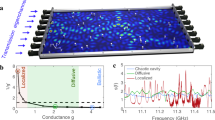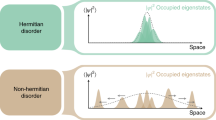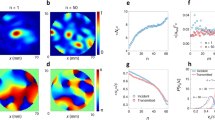Abstract
In 1958, Philip Anderson argued that disorder can transform a conductor into an insulator, as multiple scattering from disorder brings transport to a complete halt. This concept, known as Anderson localization, has been tested in electronic, optical, acoustic and matter wave systems, which have all shown that disorder generally works to arrest transport. One major condition is common to all work on Anderson localization: for localization to take place, the underlying potential must be constant in time (frozen). Otherwise, if the disorder is dynamically evolving, localization breaks down and diffusive transport is expected to prevail. However, it seems natural to ask: can disorder increase the transport rate beyond diffusion, possibly even beyond ballistic transport? Here, we use a paraxial optical setting as a model system, and demonstrate experimentally and numerically that an evolving random potential gives rise to stochastic acceleration, which causes an initial wave packet to expand at a rate faster than ballistic, while its transverse momentum spectrum continuously expands. We discuss the universal aspects of the phenomenon relevant for all wave systems containing disorder.
This is a preview of subscription content, access via your institution
Access options
Subscribe to this journal
Receive 12 print issues and online access
$209.00 per year
only $17.42 per issue
Buy this article
- Purchase on Springer Link
- Instant access to full article PDF
Prices may be subject to local taxes which are calculated during checkout



Similar content being viewed by others
References
Anderson, P. W. Absence of diffusion in certain random lattices. Phys. Rev. 109, 1492–1505 (1958).
Lee, P. A. & Ramakrishnan, T. V. Disordered electronic systems. Rev. Mod. Phys. 57, 287–337 (1985).
Schwartz, T., Bartal, G., Fishman, S. & Segev, M. Transport and Anderson localization in disordered two-dimensional photonic lattices. Nature 446, 52–55 (2007).
Lahini, Y. et al. Anderson localization and nonlinearity in one-dimensional disordered photonic lattices. Phys. Rev. Lett. 100, 013906 (2008).
Wiersma, D. S., Bartolini, P., Lagendijk, A. & Righini, R. Localization of light in a disordered medium. Nature 390, 671–673 (1997).
Chabanov, A. A., Stoytchev, M. & Genack, A. Z. Statistical signatures of photon localization. Nature 404, 850–853 (2000).
Störzer, M., Gross, P., Aegerter, C. M. & Maret, G. Observation of the critical regime near Anderson localization of light. Phys. Rev. Lett. 96, 063904 (2006).
Billy, J. et al. Direct observation of Anderson localization of matter waves in a controlled disorder. Nature 453, 891–894 (2008).
Giacomo, R. et al. Anderson localization of a non-interacting Bose–Einstein condensate. Nature 453, 895–898 (2008).
Kondov, S. S., McGehee, W. R., Zirbel, J. J. & DeMarco, B. Three-dimensional Anderson localization of ultracold matter. Science 334, 66–68 (2011).
Jendrzejewski, F. et al. Three dimensional localization of ultracold atoms in an optical trap. Nature Phys. 8, 398–403 (2012).
Hu, H., Strybulevych, A., Page, J. H., Skipetrov, S. E. & van Tiggelen, B. A. Localization of ultrasound in a three dimensional elastic network. Nature Phys. 4, 945–948 (2008).
Kampen, N. V. Stochastic Processes in Physics and Chemistry 3rd edn (North Holland, 2007).
Zaslavskii, G. M. & Chirikov, B. V. Stochastic instability of nonlinear oscillation. Sov. Phys. Usp. 14, 549–567 (1972).
Jayannavar, A. M. & Kumar, N. Nondiffusive quantum transport in a dynamically disordered medium. Phys. Rev. Lett. 48, 553–556 (1982).
Golubovic, L., Feng, S. & Zeng, F. Classical and quantum superdiffusion in a time-dependent random potential. Phys. Rev. Lett. 67, 2115–2118 (1991).
Rosenbluth, M. N. Comment on Classical and quantum superdiffusion in a time-dependent random potential. Phys. Rev. Lett. 69, 1831–1831 (1992).
Arvedson, E., Wilkinson, M., Mehlig, B. & Nakamura, K. Staggered ladder spectra. Phys. Rev. Lett. 96, 030601 (2006).
De Raedt, H., Lagendijk, A. & de Vries, P. Transverse localization of light. Phys. Rev. Lett. 62, 47–50 (1988).
Longhi, S. Quantum-optical analogies using photonic structures. Laser Photon. Rev. 3, 243–261 (2009).
Lederer, F. et al. Discrete solitons in optics. Phys. Rep. 463, 1–126 (2008).
Martin, L. et al. Anderson localization in optical waveguide arrays with off-diagonal coupling disorder. Opt. Express 19, 13636–13646 (2011).
Lahini, Y. et al. Observation of a localization transition in quasiperiodic photonic lattices. Phys. Rev. Lett. 103, 013901 (2009).
Levi, L. et al. Disorder-enhanced transport in photonic quasicrystals. Science 332, 1541–1544 (2011).
Szameit, A. et al. Wave localization at the boundary of disordered photonic lattices. Opt. Lett. 35, 1172–1174 (2010).
Barthelemy, P., Bertolotti, J. & Wiersma, D. S. A Lévy flight for light. Nature 453, 495–498 (2008).
Zhang, S., Park, J., Milner, V. & Genack, A. Z. Photon delocalization transition in dimensional crossover in layered media. Phys. Rev. Lett. 101, 183901 (2008).
Efremidis, N. K., Sears, S. & Christodoulides, D. N. Discrete solitons in photorefractive optically induced photonic lattices. Phys. Rev. E 66, 046602 (2002).
Fleischer, J. W., Carmon, T., Segev, M., Efremidis, N. K. & Christodoulides, D. N. Observation of discrete solitons in optically induced real time waveguide arrays. Phys. Rev. Lett. 90, 023902 (2003).
Fleischer, J. W., Segev, M., Efremidis, N. K. & Christodoulides, D. N. Observation of two-dimensional discrete solitons in optically induced nonlinear photonic lattices. Nature 422, 147–150 (2003).
Segev, M., Valley, G. C., Crosignani, B., DiPorto, P. & Yariv, A. Steady-state spatial screening solitons in photorefractive materials with external applied field. Phys. Rev. Lett. 73, 3211–3214 (1994).
Gurevich, E. & Kenneth, O. Lyapunov exponent for the laser speckle potential: A weak disorder expansion. Phys. Rev. A 79, 063617 (2009).
Lugan, P. et al. One-dimensional Anderson localization in certain correlated random potentials. Phys. Rev. A 80, 023605 (2009).
Shapiro, B. Cold atoms in the presence of disorder. J. Phys. A 45, 143001 (2012).
Krivolapov, Y., Levi, L., Fishman, S., Segev, M. & Wilkinson, M. Super-diffusion in optical realizations of Anderson localization. New J. Phys. 14, 043047 (2012).
Krivolapov, Y. & Fishman, S. Universality classes of transport in time-dependent random potentials. Phys. Rev. E 86, 030103 (2012).
Saleh, B.E.A. & Teich, M.C. Fundamentals of Photonics Ch. 20 (Wiley, 1991).
Moharam, M. G. & Young, L. Criterion for Bragg and Raman-Nath diffraction regimes. Appl. Opt. 17, 1757–1759 (1978).
Peruzzo, A. et al. Quantum walks of correlated photons. Science 329, 1500–1503 (2010).
Abouraddy, A. F., Di Guiseppe, G., Christodoulides, D. N. & Saleh, B. E. A. Anderson localization and co-localization of spatially entangled photons. Phys. Rev. A 86, 040302 (2012).
Acknowledgements
This research was supported by an Advanced Grant from the European Research Council, by the Israel Science Foundation and by the USA–Israel Binational Science Foundation.
Author information
Authors and Affiliations
Contributions
The experiments were carried out by L.L. All authors contributed to this research.
Corresponding author
Ethics declarations
Competing interests
The authors declare no competing financial interests.
Rights and permissions
About this article
Cite this article
Levi, L., Krivolapov, Y., Fishman, S. et al. Hyper-transport of light and stochastic acceleration by evolving disorder. Nature Phys 8, 912–917 (2012). https://doi.org/10.1038/nphys2463
Received:
Accepted:
Published:
Issue Date:
DOI: https://doi.org/10.1038/nphys2463
This article is cited by
-
Isotropic gap formation, localization, and waveguiding in mesoscale Yukawa-potential amorphous structures
Communications Physics (2024)
-
Great Barrier Reef degradation, sea surface temperatures, and atmospheric CO2 levels collectively exhibit a stochastic process with memory
Climate Dynamics (2021)
-
Engineered disorder in photonics
Nature Reviews Materials (2020)
-
Optimal crosstalk suppression in multicore fibers
Scientific Reports (2019)
-
Environmental engineering for quantum energy transport
npj Quantum Information (2018)



